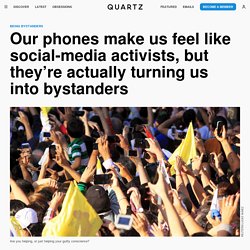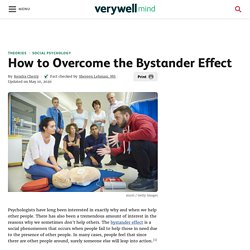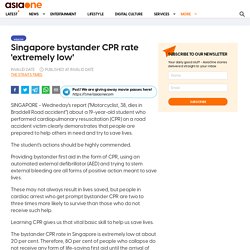

Oriana
Bystander effect (Bauman et. al, 2020) Response of a witness. Girls comforting their friends. Witness that are closely acquainted with victims. Children with greater sense of empathy. Children that are expected to be smart and behave well. Why are bystanders so important? Bystanders ignoring person on the road. Bystander inaction, like 7-Eleven assault, more likely with more witnesses, experts say - Chicago Tribune. The bystander effect is being made worse by people filming violent events on their smartphones. On April 9, 2017, a video of a man being dragged off a United Airlines flight was posted on the internet and went viral.

But I don’t need to tell you that. Each of your most outspoken Facebook friends probably posted about the event, highlighting the aspects of it that best reinforced their worldview. The incident was covered all over American media and even sparked outrage in China. The collective focus may have now moved on to its next source of outrage, but there was something that only a few people noticed in the moment: a plane full of quiet passengers.
Other than one woman screaming, hardly anyone else on the plane seemed bothered enough by what was happening to raise a ruckus. Instead of intervening in the assault, the passengers stoically took out their cameraphones and pointed them toward David Dao, whose body was dragged along the aisle of the airplane, glasses askew, face bloody, and belly exposed. How to Overcome the Bystander Effect. Psychologists have long been interested in exactly why and when we help other people.

There has also been a tremendous amount of interest in the reasons why we sometimes don't help others. The bystander effect is a social phenomenon that occurs when people fail to help those in need due to the presence of other people. In many cases, people feel that since there are other people around, surely someone else will leap into action.1 While the bystander effect can have a negative impact on prosocial behavior, altruism and heroism, researchers have identified a number of different factors that can help people overcome this tendency and increase the likelihood that they will engage in helping behaviors.2 Some of these include: Witnessing Helping Behavior Sometimes just seeing other people doing something kind or helpful makes us more willing to help others.
Imagine that you are walking into a large department store. Being Observant. Overcoming the Bystander Effect. Helping in a small manner. A small gesture of yours can go a long way. Being observant of your surroundings. Administering CPR on victims of cardiac arrest. Helping to save a life, Singapore News. Seven out of 10 out-of-hospital cardiac arrest happened at home — a scary reminder that it can happen to anyone, anywhere, anytime.
Out-of-hospital cardiac arrest (OHCA) is a leading cause of death in Singapore, which accounts for more than 2,000 deaths annually. Cardiac arrest occurs when the heart suddenly stops beating. Someone who suffers from sudden heart stop will suddenly lose consciousness and will stop breathing or stop breathing normally. And it is not a problem exclusive to the aged population. Half of those who suffered from cardiac arrest were below 65 years old.
Unfortunately, most Singaporeans are not equipped with the knowledge and skills to respond to such situations. In Singapore, the benchmark survival rate for cardiac arrest is about 11 per cent, which is low compared to cities such as Seattle, Tokyo or Seoul, where survival rates are up to 50 per cent. Life-saving skills Time is of the essence during a cardiac arrest. Singapore bystander CPR rate 'extremely low', Health News. SINGAPORE - Wedneday's report ("Motorcyclist, 38, dies in Braddell Road accident") about a 19-year-old student who performed cardiopulmonary resuscitation (CPR) on a road accident victim clearly demonstrates that people are prepared to help others in need and try to save lives.

The student's actions should be highly commended. Providing bystander first aid in the form of CPR, using an automated external defibrillator (AED) and trying to stem external bleeding are all forms of positive action meant to save lives. These may not always result in lives saved, but people in cardiac arrest who get prompt bystander CPR are two to three times more likely to survive than those who do not receive such help. Learning CPR gives us that vital basic skill to help us save lives. The bystander CPR rate in Singapore is extremely low at about 20 per cent. Our community is the first line of defence against unnecessary deaths. The public can help save lives by doing the following: You need not be a hero to provide assistance to others, you can become a small hero present in our everyday lives with just a small gesture!